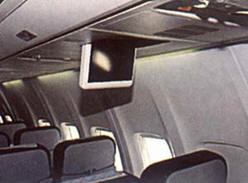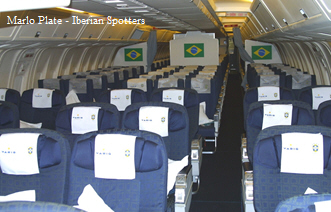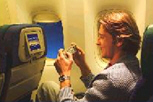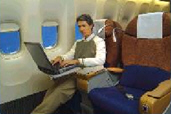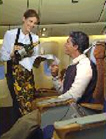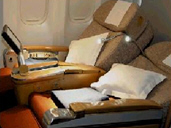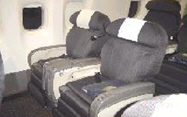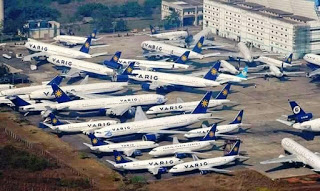|



In October 2000 Varig Log was created
already as the largest cargo airline in Latin America,
with eleven cargo airplanes. In 2001 VEM (Varig
Engineering and Maintenance) became a separate company
and was ranked as one of the top ten in the world.
At the end of 2001 VARIG received its first Boeing
777-200ER and Boeing 737-800 with winglet.
The two aircraft represented the future, Boeing 777
became new fleet star and would replace MD-11, while
Boeing 737-800 would replace most previous generation
Boeing 737. The first Boeing 777 was named "Otto
Meyer" and began service on Rio de Janeiro - Sao Paulo -
London - Copenhagen route. The second B777 was named
"Ruben Berta" and started flights on Rio de Janeiro -
Sao Paulo - Paris - Amsterdam route.
But 2001 was
also a very difficult year for the entire industry. The
two Brazil's largest airlines, Varig and Tam, started a
codeshare agreement in domestic market, in 2003, ended
at the same year.
In 2003 and 2004 VARIG started a full restructuring
program, culminating with the merger with its regional
subsidiaries Rio Sul and Nordeste. After the merger,
VARIG’s fleet reached more than 120 aircraft and
incorporated Boeing 737-500 and Embraer ERJ-145. Also in
2004 VARIG received more Boeing 777 and four Boeing
757-200.
The B757 soon pleased passengers, and became known as
the aircraft more comfortable in the domestic market at
the time. Regarding the network, VARIG became the first
company in Latin America to operate to China. Together
with Air China, VARIG began selling tickets on São Paulo
- Munich - Beijing route.
Despite efforts, VARIG filed for bankruptcy in 2005. To
capitalize itself, the company sold VEM for Tap and Varig
Log for Volo Brazil.
However, this only gave time to survive few more months.
In 2006 the situation reached the limit, the company had
no money. On evidence that VARIG was a single company,
its employees went to work without receiving salary. In
a demonstration of love and trust in the company's
future, VARIG employees brought items of their own homes
as coffee powder to serve the passengers. Meanwhile the
fleet decreased every day, aircraft stopped operating
because the company had no money to do maintenance or
because they were arrested for no leasing payment. As a
consequence, the network was adjusted to fit a smaller
fleet. Many destinations started being canceled such as
Nagoya, Tokyo, Cancun, Lisbon, Milan, Madrid, Munich,
Paris, Los Angeles, New York, Mexico City, Montevideo,
Asunción and Bogotá. By the beginning of July 2006,
VARIG was reduced to a fleet of ten aircraft and seven
destinations.
In July, 2006 VARIG was divided into two companies and auctioned. The "new Varig" was sold to Volo Brasil continued to operate under VARIG’s license until get its own license to operate. In April, 2007 the "new VARIG" was bought by Gol airlines and started a rapid fleet and network expansion. But the plan did not go as expected and Gol gave up investing in VARIG brand. VARIG's remaining aircraft were slowly disappearing from the skies, until completely disappeared in August, 2014. The "old VARIG" tried rebuild and launched a charter airline named "Flex" on March, 2007. But in a short time the company ceased again. On August 20, 2010 was declared the bankruptcy of S.A. Viação Aérea Rio Grandense - VARIG.



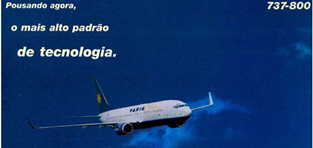


 |
|
HOW WAS FLYING IN THE 2000s?
What was already
influencing Brazil since the 90s, arrived in 2000 after the creation
of low cost, low fare Gol airlines. In Brazil, the effect of Gol
made the “traditional airlines” adapt itself to compete in this new
reality. After Gol airlines, ticket’s price dropped by half and
aircraft now have more seats and less space.
VARIG’s Economy Class offered more space compared to other airlines. Meals were another differential, main meal (usually hot), accompanied by salad, fruit, chocolate and various beverages. Passenger could also request special meals such as vegetarian, gluten free and lactose free.
In the 2000s business class on domestic flights was extinguished. In VARIG’s Business Class passengers enjoyed more space and greater reclining. In addition on board service offered two entry options, four hot meal options and a dessert with fruit or cheese. Drinks follow the concept VARIG’s First and Wines of the World program. The entertainment of VARIG’s Business had individual video devices in seven different languages. On flights over six hours, passengers receive high quality “nécessaire” with comfort items and products of Amazon forest.
VARIG’s First Class offered personalized services. The service followed the "Restaurant Style" philosophy, with a diverse menu and option for lower calorie meal and ingredients that minimize jet lag effects. Passengers also had individual video entertainment in seven different languages. Passengers received high quality “nécessaire” with comfort items and products of Amazon forest.
|
|
2000s |
||
|
Fleet evolution (VARIG Group):




VARIG's international route map - 2000s / Boeing 757

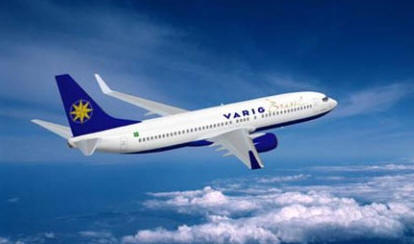



 |
|
FOCUS: Varig's crisis
|

Also know
about all aircraft operated by VARIG!





